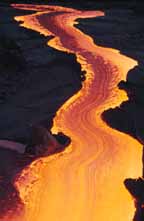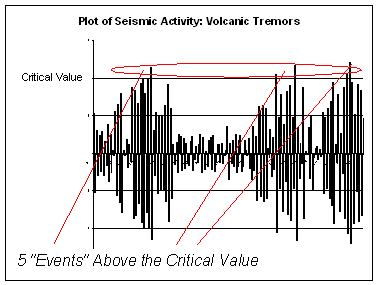 |
Volcanic
Dangers
It's spectacular and, oh, so deadly.
 A
volcanic eruption can be one of nature's most spectacular events.
Sprays of lava and debris shoot skyward. A roar that would make
thunder seem a mere whisper splits the silence. Flaming lava
rivers flow downward through ravines and over ledges creating
lava cascades of fiery reds and golds. A
volcanic eruption can be one of nature's most spectacular events.
Sprays of lava and debris shoot skyward. A roar that would make
thunder seem a mere whisper splits the silence. Flaming lava
rivers flow downward through ravines and over ledges creating
lava cascades of fiery reds and golds.
A violent eruption may send solid and molten rock fragments,
ash, and volcanic gases into the air with tremendous force.
The force is so great that the erupting column and the huge,
billowing cloud that form above it can rise many kilometers
into the atmosphere.
Much of the material ejected from a volcano
is known as “tephra.” The largest fragments (greater
than 64 mm) are called blocks and bombs. Small, fiery blocks
and bombs have been known to travel as far away as 20-80 km.
Fragments smaller than 2 mm are often simply called “ash."
The ash forms a dust-like blanket of very tiny shards of volcanic
rock and glass wherever it settles. It clogs machinery, smothers
crops, and, when combined with rain, collapses roofs and breaks
tree branches. The smallest particles which are less than .01
mm can stay in the atmosphere for months after a volcanic eruption.
Sometimes these particles produce fantastic sunsets such as
those seen after the eruption of Mt. Pinatubo in 1991.
Volcanoes also spew gaseous substances. Volcanic
gases, made of steam mixed with carbon dioxide, sulfur dioxide,
hydrogen sulfide, hydrogen, and/or fluorine, filter into the
atmosphere, contaminating the air and groundwater, poisoning
animals, killing plants with the acid rain that follows, and
causing breathing problems. Small droplets of sulfuric acid
which remain in the atmosphere for months or years may even
contribute to global warming.
Dangers that don't burst out of a volcano
flow down it. There are four types of deadly volcanic flows
that threaten man and nature.
- Lava flows are streams of molten rock on
the Earth's surface. They pour out of the erupting volcano
and flow down its sides at speeds ranging from a few kilometers
per hour to over eighty kilometers per hour. Molten rock when
it is still underground is called "magma." Once
it reaches the surface we call it "lava."
- Pyroclastic flows contain hot ash, rock
fragments, and gases that can flow from volcanoes at speeds
in excess of one hundred fifty kilometers per hour.
- Volcanic landslides consist of rocks, snow,
or ice on the slopes of the volcano, which are loosened and
sent tumbling downhill by seismic or eruptive activity.
- Lahars (also referred to as "volcanic
mudflows" or "debris flows") are a mixture
of volcanic ash and debris and water. This deadly mix, with
the consistency of wet concrete, flows down valleys and stream
channels, rips out trees and houses, and eventually buries
everything in its path. The water that mixes with the debris
to start the lahar can come from glacial ice on the volcano's
slopes or from heavy rains. As long as these deposits remain
on the hillsides, lahars triggered by heavy rainfall can occur
without warning, for years after a volcano erupts— a
deadly, volcanic legacy.
Predicting Eruptions
No one can predict exactly when a volcano
might erupt. There are, however, common clues to look for to
let people know that the danger is increasing:
- Land deformation. Near the volcanic vent,
as magma pushes up from below, the land on top of and surrounding
the vent may start to deform, and grow larger. In many cases
this deformation creates a dome of volcanic debris. As the
dome grows in size, it becomes more unstable, and ultimately
it will collapse and produce pyroclastic flows or lava flows.
Increasing dome size indicates a growing danger.
- Ash Clouds. Large ash clouds are evidence
of increasing volcanic activity. On the island of Montserrat
scientists have found that during dangerous times, ash clouds
occur in a cycle of 4 to 30 hours apart. What causes an ash
cloud? In an active volcano, the vent may become plugged by
rocky materials. This plug causes the pressure from the rising
magma to build until eventually the plug is blasted apart
in a flurry of explosive activity. The released pressure creates
an ash cloud, shooting volcanic debris high into the air.
Once an ash cloud is produced, the vent may become plugged
again and the cycle may repeat. If a plugged volcano does
not release its pressure, then scientists become concerned
that a massive explosion is imminent. As long as the ash clouds
keep appearing regularly, then there is less concern.
- Tremors. Flowing magma, trying to make
room for itself, causes tremors on the surface. Tremors are
measured both for their magnitude and the length of time between
vibrations, or rate. On the island of Montserrat, scientists
study two kinds of seismic data: Volcanic Tremors (VTs) and
Rockfall (RF). The number of tremors or falling rocks which
exceed a predetermined critical value are counted by the seismometer
(see illustration). The more of these “events”
the greater the level of the seismic activity. The rate of
tremors is determined by charting the number of events per
hour. An increase in the number of events can be an indication
of possible eruption.

Infamous moments in volcanic
history
- The eruption of Mount Vesuvius in Italy, in 79A.D.,
spewed ashes and lava fragments that buried the city
of Pompeii and caused a mudflow that destroyed the nearby
city of Herculaneum.
- The 1883 eruption of Krakatoa in Indonesia, considered
one of the most catastrophic in history, set off explosions
that could be heard almost three thousand miles away;
spewed gases and vapors that rose to a height of seventeen
miles (twenty seven kilometers); and let loose a tsunami
that killed thirty six thousand people on nearby islands.
|

Review Questions
- Describe how an erupting volcano can affect the atmosphere.
Explain how this could contribute to global warming.
- From this article, what are described as the dangerous short-term
effects from a volcanic eruption? What are the dangerous long-term
effects?
- Explain how magma under the surface can create seismic tremors.
|
 |